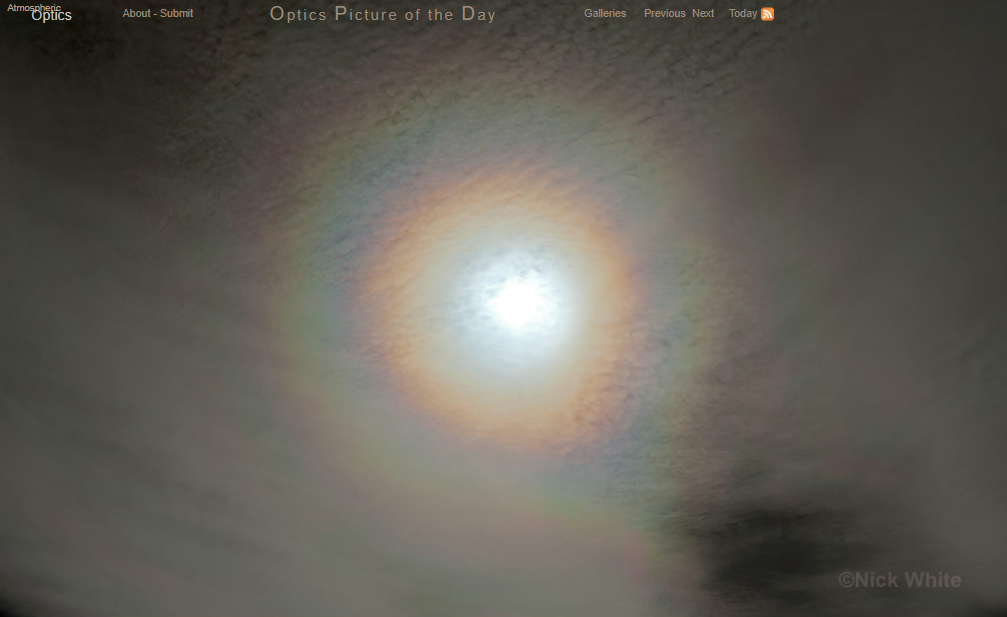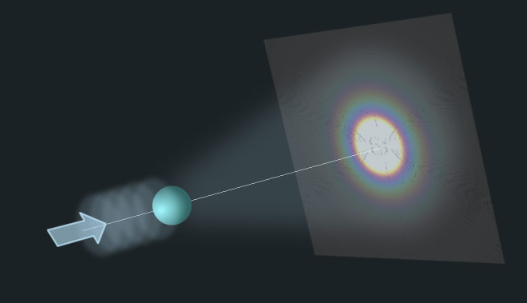OPOD - Oxfordshire Solar Corona
OPOD - Oxfordshire Solar Corona
Have you ever witnessed the breathtaking beauty of a solar corona? Nick White captured this exquisite phenomenon along with iridescence in Autumnal altocumulus clouds over Thame, Oxfordshire, England. The corona, characterized by its circular diffraction pattern, is formed by the scattering of light primarily by the outer skins of cloud droplets.
Cloud droplets, with diameters ranging from 1 to 100 microns (0.001 - 0.1 mm), are remarkably close in size to the wavelengths of visible light. This proximity to the size of light waves plays a crucial role when light interacts with these tiny spheres. As light waves encounter the droplets, they scatter in all directions, creating a mesmerizing display of colors.
The scattered waves from each point on the surface of the droplet overlap and interfere with each other. When waves are in-phase, they reinforce each other, while out-of-phase waves cancel each other out. This interference phenomenon results in a circular diffraction pattern known as the corona. The intricate interplay between light waves and cloud droplets showcases the wave aspect of light and serves as a testament to the minuteness of these droplets.
The appearance of chaotic iridescent colors within the corona further adds to its allure. These colors arise from the interaction between light and the irregularities on the surface of the cloud droplets. As light passes through these irregularities, it undergoes diffraction, causing the colors to scatter and blend together in a captivating manner.
It is worth noting that this article has been automatically converted from the old site and may not appear exactly as intended. For the original article, you can visit here.
In summary, the Oxfordshire solar corona captured by Nick White showcases the beauty and complexity of atmospheric optics. The corona's circular diffraction pattern serves as a testament to the minuteness of cloud droplets and the wave nature of light. The addition of chaotic iridescent colors adds a touch of unpredictability to this natural phenomenon. If you ever have the opportunity to witness a solar corona, take a moment to marvel at the intricate interplay between light and the tiny droplets suspended in the atmosphere.

Solar Corona - Nick White (Photography) pictured this exquisite corona and iridescence in Autumnal altocumulus cloud over Thame, Oxfordshire, England. ©Nick White, shown with permission.

The corona, and more chaotic iridescent colours, are the products of light scattered mainly by the outer skins of cloud droplets.
The droplets are only 1-100 micron (0.001 - 0.1 mm) diameter and not that far removed from the wavelengths of visible light. The wave aspect of light therefore becomes important when it impacts on the tiny spheres.
Scattered waves radiate outwards from all points on the drop surface. Where they overlap they interfere. Waves in-phase reinforce and waves out of phase are destroyed. The result is a circular diffraction pattern.
The coronal diffraction pattern is a sign writ large in the sky of the minuteness of cloud drops and the wave aspect of light.
Note: this article has been automatically converted from the old site and may not appear as intended. You can find the original article here.
Reference Atmospheric Optics
If you use any of the definitions, information, or data presented on Atmospheric Optics, please copy the link or reference below to properly credit us as the reference source. Thank you!
-
<a href="https://atoptics.co.uk/blog/opod-oxfordshire-solar-corona/">OPOD - Oxfordshire Solar Corona</a>
-
"OPOD - Oxfordshire Solar Corona". Atmospheric Optics. Accessed on November 25, 2024. https://atoptics.co.uk/blog/opod-oxfordshire-solar-corona/.
-
"OPOD - Oxfordshire Solar Corona". Atmospheric Optics, https://atoptics.co.uk/blog/opod-oxfordshire-solar-corona/. Accessed 25 November, 2024
-
OPOD - Oxfordshire Solar Corona. Atmospheric Optics. Retrieved from https://atoptics.co.uk/blog/opod-oxfordshire-solar-corona/.